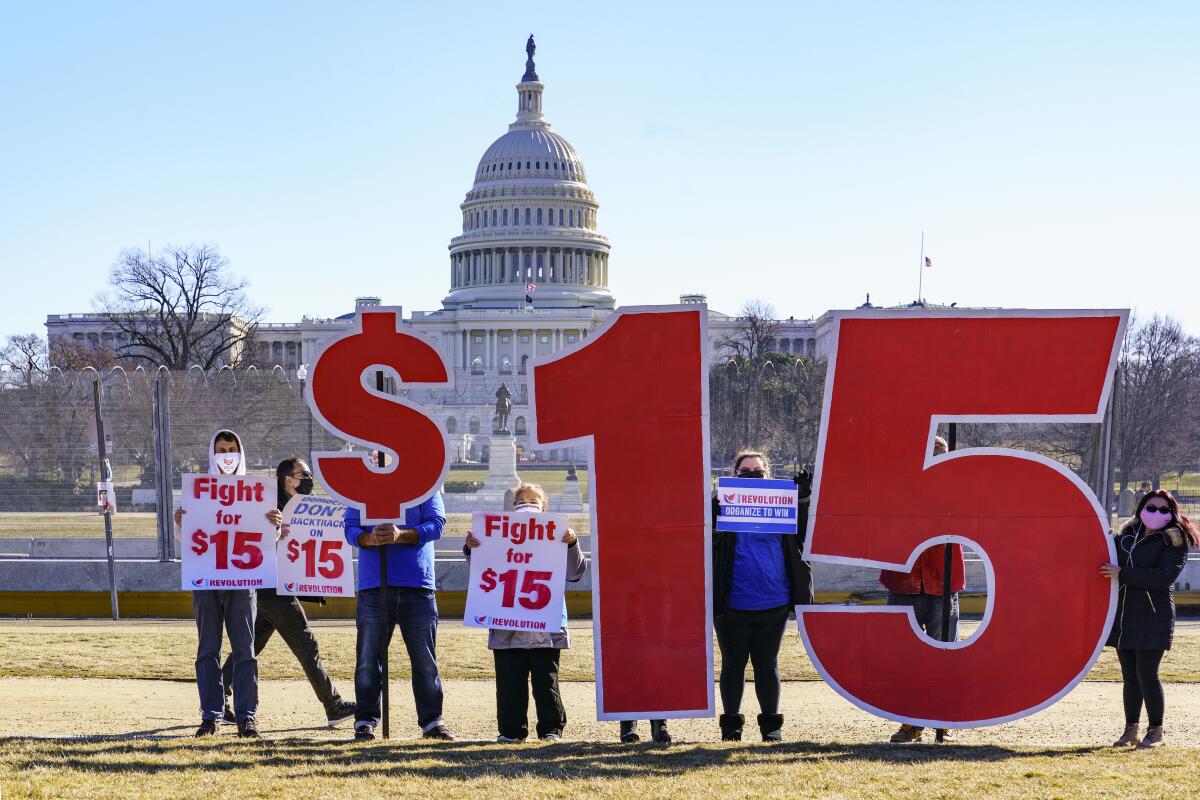Commentary: California workers urgently need an $18 minimum wage. The Legislature should act this year

- Share via
Californians may have gotten temporary relief recently when gas prices finally fell to about $6 a gallon this month, down from as high as $8 per gallon in June in Los Angeles County. Inflation has rocked the economy, soaring 9.1% from a year ago in June.
But even before inflation spiked, Californians were already weathering an affordability crisis. California has some of the nation’s highest housing expenses, the most expensive gas and the third highest overall cost of living. A single adult in California needs to earn at least $21.82 an hour to make ends meet, according to a living wage calculator by the Massachusetts Institute of Technology. If you’re a single parent with one child, that figure rises to $44 and nearly $55 if you have two kids. It’s no surprise nearly half of residents surveyed earlier this year were considering ditching the state altogether.
California’s low-wage workers need a minimum wage hike. The Legislature should make it happen.
Californians almost got a chance to vote to raise the minimum wage this year. In December, entrepreneur and anti-poverty advocate Joe Sanberg launched the campaign to put the California Living Wage Act of 2022 on the November ballot. The initiative aimed to gradually raise the state’s minimum wage to $18 by 2025. But it failed to qualify for the upcoming election because counties were unable to verify enough signatures in time. Sanberg sued to force Secretary of State Shirley Weber to place the measure on this year’s ballot, but a judge last week found that Weber had acted properly and ruled against the campaign for missing a key deadline. The measure has instead qualified for the 2024 ballot.
A November 2022 ballot cluttered with niche industry fights is not good for voters. Elected officials should use their power to broker compromises.
If voters want a minimum wage bump sooner, it will likely need to come from the Legislature.
Lawmakers could introduce a bill to raise the minimum wage one dollar each year until it reaches $18 an hour in 2025, similar to the California Living Wage Act.
California Assembly Speaker Anthony Rendon’s office told me he hasn’t weighed in on the lawsuit but that “he’s always supportive of efforts to raise the minimum wage.” Good. Then why wait for voters to decide in 2024? The Legislature and Gov. Gavin Newsom could act sooner to lift up low-wage earners.
In 2016, the Legislature passed a $15 minimum wage, with polling suggesting most voters supported the policy. Now there may be concerns that raising the minimum wage will fuel inflation by increasing the costs of goods and labor. But that shouldn’t be a serious worry. A policy brief by Michael Reich, a professor at UC Berkeley, found that if implemented, the California Living Wage Act would raise prices by just .042% over three years, debunking possible fears that higher wages will stoke inflation.
The brief also found that raising the minimum wage to $18 by 2025 would lift 3.5 million Californians above the federal poverty line and would give each affected worker an average annual income boost of $1,349. This has “small, minuscule effects on prices,” Ken Jacobs, chair of the UC Berkeley Center for Labor Research and Education, told me. But he said it has a “meaningful effect on wage workers’ pay.”
Another reason fears of inflation are likely unwarranted: The proposal isn’t a large step up in wages. Jacobs estimates that the $1,349 average income boost represents a roughly 5% increase in workers’ wages. “The thing that really struck us is how this is a very modest proposal,” Jacobs said. “The costs are extraordinarily small for very meaningful benefits for the families who gain higher wages.”
That doesn’t mean such a measure would have no effect on businesses and consumer prices. Studies find that minimum wage laws result in a modest rise in prices and a minimal increase in unemployment rates in some sectors, such as manufacturing. The policy brief reports that minimum wage workers are concentrated in just a few industries. Two of them — restaurants and retail — employ 31% of California’s minimum wage workers and would shoulder the costs associated with an $18 minimum wage by raising prices for consumers. But the brief notes the price increases are not expected to be large enough to significantly drive down consumer demand in those industries.
Still, some businesses, especially those with few employees and thin profit margins, could suffer as a result of raising the minimum wage, and their costs could very well increase, even if the overall burden on the economy is slight.
Trials of guaranteed income programs in L.A. could show whether giving poor people cash can actually reduce poverty. Gathering data will be crucial.
“Call small businesses and ask them when the minimum wage goes up if they will eat it or if they will pass the cost on to their customer. I bet if you called 50, all 50 would tell you, ‘Yes, we will pass the cost of the increased expense on to our customers,’” Clint Olivier, CEO of Business Federation of the Central Valley and a former Fresno City Council member, told me.
This is the heart of policymaking: accepting necessary trade-offs. In this case, the need for poverty relief should be our top priority. The merits and established benefits of a higher minimum wage outweigh the risks to some businesses and industries.
With a minimum wage roughly twice of the $7.25 federal mandate, California is sometimes perceived as a state of progress and prosperity. But for many the reality is one of crummy wages and a cycle of poverty; the state’s average per capita income was still a meager $38,576 in 2020, according to the Census Bureau, with the highest poverty rate in the country when the cost of living is factored in.
If the Legislature doesn’t act now, workers could lose the crucial gains of this measure. Though 37 localities have their own higher wage standards and inflation adjustments, some of which could reach close to $18 by 2025, many others do not. The UC Berkeley policy brief notes that two-thirds of California’s private sector workers live outside such counties, meaning they would only receive the state’s automatic minimum wage increase. That figure is set to reach $16.50 by 2025.
It’s time to give workers a dignified wage — one that affords them adequate food, housing and transportation. Let’s give California’s workers the pay they deserve.
More to Read
A cure for the common opinion
Get thought-provoking perspectives with our weekly newsletter.
You may occasionally receive promotional content from the Los Angeles Times.













